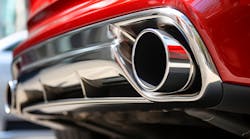Last year, there were 1,189,051 electric vehicles sold in the U.S., or 7.6% of all new car sales and according to Kelley Blue Book a new record total for EV sales, up from 5.9% in 2022. Impressive results, it is reported, but far from encouraging to the domestic automakers who operate under severe pressure from the federal government to ‘transition’ the U.S. market away from internal combustion engines by 2030. But it turns out that the automakers are also under some pressure from car buyers – 92.4% of whom did not prefer an EV last year.
After decades of guiding automotive design through Corporate Average Fuel Economy standards, initially to maximize fuel efficiency in order to conserve resources and benefit consumers, the objective switched in 2009 to target tailpipe emissions. Electric and hybrid vehicles were not new technologies, but no automaker was prepared to manufacture EVs in volumes that would fulfill the EPA’s targets. So the shift was on to adapt automotive design and production to meet the mandate.
“Mandate” and “demand” have similar implications, except in the economic sense. The federal mandates do not coincide with consumer demand in the matter of electric vehicles – and that’s been a mounting problem for automakers. The evidence shows that buyers want affordable, reliable vehicles that will offer them the flexibility and autonomy that cars have always offered. So far, EVs are not convincing them on that score.
It wasn’t simply federal mandates that drove the auto industry to shift their production programs away from ICE vehicle technologies over the past decade. They had their own research to tell them that there was a market waiting for the EVs they promised would overtake their offerings as this decade proceeded.
And in the course of this shift the automakers have largely revamped their corporate structures to fulfill the electrification objective. They are not simply automakers any longer; they’re fuel-cell and battery manufacturers, in order to power the vehicles they’re introducing. They’re resource mining firms in order to power the energy technologies they are developing for those fuel cells. And they’re program developers in order to draft the systems that guide these vehicles.
That’s not all. Some automakers are among the developers of charging networks that will displace service stations, and some have got a hand in developing a grid to allow consumers to optimize their energy purchases. The point is that transitioning to a new type of product offering has become the impetus to transition their businesses into very different enterprises. The many billions of dollars invested to start this transition has excited the industry’s leadership class, at least.
The car-buying public’s tastes have been mostly unexamined, but last year’s United Autoworkers strike made the overall lack of support for electrification impossible to overlook. The protracted dispute cost the Big Three dearly, and acknowledging their non-commitment to those manufacturing jobs is a price they will continue to bear until they can make the transition to EVs complete.
That date is now postponed, however. In February the Biden Administration withdrew the stringent vehicle emission standards proposed just last April, regulations that would have required automakers to achieve 13% average annual pollution reductions on new vehicles by 2032. At that time the Administration made it known that it expected 60% of all vehicles sold to be electric-powered by 2030.
Getting the buying public from 7.6% to 60% in the six years remaining to 2030 seems impossible without a disastrous collapse in sales volumes, so for now the transition date is unknown. On hold, but not cancelled, because the EPA has made its program known and the automakers cannot dismantle the organizations they’ve built to meet that agenda.
The car-buying public’s interest is neither the climate agenda nor the corporate restructuring. Setting aside the tailpipe emission regulations shows that the regulators and automakers realize they cannot manufacture a future without a market that will accept it.









